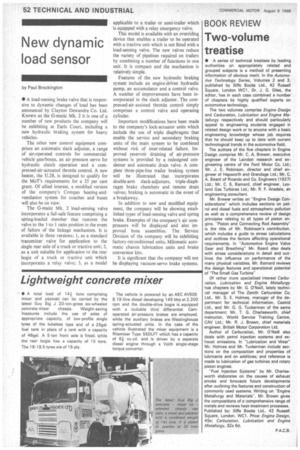New dynamic load sensor
Page 54

If you've noticed an error in this article please click here to report it so we can fix it.
by Paul Brockington • A load-sensing brake valve that is responsive to dynamic changes of load has been announced by Clayton Dewandre Co. Ltd. Known as the G-matic Mk. 2 it is one of a number of new products the company will be exhibiting at Earls Court. including a new hydraulic braking system for heavy vehicles.
The other new control equipment comprises an automatic slack adjuster, a range of airToperated controls for commercialvehicle gearboxes, an air-pressure servo for hydraulic clutch operation and a compressed-air-actuated throttle control. A new heater, the U.28, is designed to qualify for the MoT's requirements for a 25 per cent grant. Of allied interest, a modified version of the company's Compas heating-andventilation system for coaches and buses will also be on view.
The G-matic Mk. 2 load-sensing valve incorporates a fail-safe feature comprising a spring-loaded member that restores the valve to the 1-to-I ratio position in the event of failure of the linkage mechanism. It is available in three versions; 1, as a standard transmitter valve for application to the single rear axle of a truck or tractive unit; 2, as a unit suitable for application to the rear bogie of a truck or tractive unit which incorporates a relay valve; 3, as a model applicable to a trailer or semi-trailer which is equipped with a relay emergency valve.
This model is available with an overriding device that enables a trailer to be operated with a tractive unit which is not fitted with a load-sensing valve. The new valves reduce the variety of pipelines required on trailers by combining a number of functions in one unit. It is compact and the mechanism is relatively simple.
Features of the new hydraulic braking system include an engine-driven hydraulic pump, an accumulator and a control valve. A number of improvements have been incorporated in the slack adjuster. The compressed-air-assisted throttle control simply comprises a control valve and operating cylinder.
Important modifications have been made to the company's lock-actuator units which include the use of triple diaphragms that enable the service and secondary braking units of the main system to be combined without risk of inter-related failure. Improved reservoir draining of air-pressure systems is provided by a redesigned condenser and automatic drain valve. A complete three-pipe-line trailer braking system will be illustrated that incorporates double-arm slack-adjusters, triple-diaphragm brake chambers and remote drain valves; braking is automatic in the event of a breakaway.
In addition to new and modified equipment, the company will be showing established types of load-sensing valve and spring brake. Examples of the company's air compressors will be displayed and also improved hose assemblies. The Service Division of the company will be exhibiting factory-reconditioned units, Milomatic automatic chassis lubrication units and brake conversion kits.
It is significant that the company will not be displaying vacuum-servo brake systems.
















































































































































